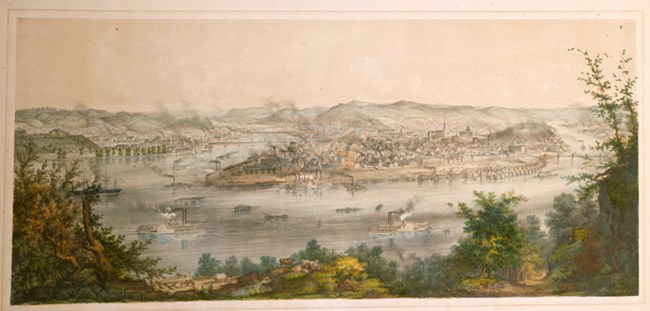Last updated: January 8, 2025
Article
Pittsburgh—A Model of Climate Change History

NY Public Library
On August 31, 1803, Captain Meriwether Lewis left Pittsburgh with an initial crew of eleven, beginning their voyage of exploration. Aiming for the headwaters of the Missouri River, the Rocky Mountains, and the Pacific Ocean, the expedition stretched the young United States’ national vision across the continent. They traveled in a new fifty-five-foot-long keelboat, built in Pittsburgh. They followed a series of old paths long used by Indigenous peoples, and their journey took them through the lands of many Indigenous nations.1
Pittsburgh began as a series of frontier military forts and prospered through exploiting natural resources, using river transportation, and industrializing. Steam power, first used for shipping, spread to manufacturing and iron production. The city became an oil refining center by the late nineteenth century, but coal and iron fueled its famous steel industry. Coal, oil, and steel led to railroads, automobiles, and electrical power plants. By the mid-twentieth century, the city was often smothered in black smoke.2
In the second half of the twentieth century, smoke control laws and a shrinking steel industry helped clear the skies. By the early twenty-first century, however, Pittsburgh recognized an even greater threat in climate change. The city responded by developing a series of climate action plans starting in 2008, combining business, government, and educational efforts to reduce emissions, develop cleaner energy, and improve urban ecosystems. Pittsburgh—the site that launched the expedition—illustrates the story of climate change, with industrial development, fossil fuel powered technology, and a collective climate change response. Other sites along the Lewis and Clark Trail also connect that historic adventure with this important contemporary issue.3
Citations:
1 NPS, “Forks of the Ohio,” Pittsburgh to the Pacific: High Potential Historic Sites of the Lewis and Clark National Historical Trail, 2022, 16, https://www.nps.gov/lecl/getinvolved/upload/2022_LCNHT_HPHS_Report_508compliantUPDATE-2.pdf; Meriwether Lewis, August 30, 1803 entry, in Gary E. Moulton, Journals of the Lewis and Clark Expedition, https://lewisandclarkjournals.unl.edu/item/lc.jrn.1803-08-30; Gary E. Moulton, footnote on August 30, 1803 entry, in Moulton, Journals of the Lewis and Clark Expedition, https://lewisandclarkjournals.unl.edu/item/lc.jrn.1803-08-30.
2 William S. Dietrich II, “A Very Short History of Pittsburg,” Pittsburgh Quarterly, Fall 2008, https://pittsburghquarterly.com/articles/a-very-brief-history-of-pittsburgh/.
3 Dietrich, “A Very Short History of Pittsburg”; City of Pittsburg, “Climate Action Plan Version 3.0,” 2018, pp. 5, 18, https://pittsburghpa.gov/dcp/climate-action-plan.
